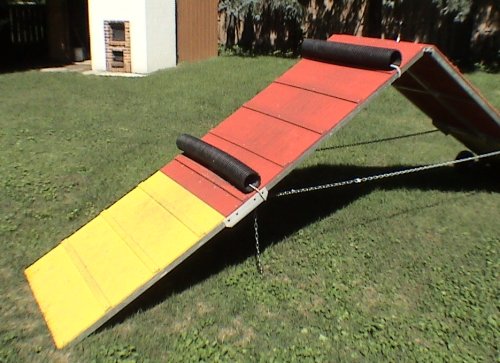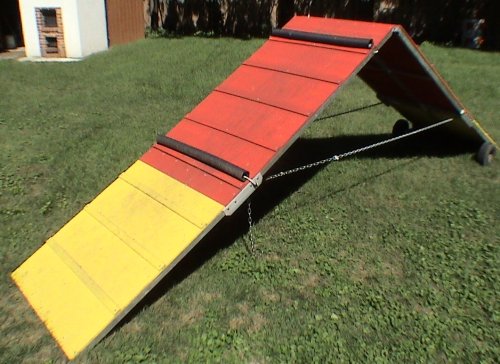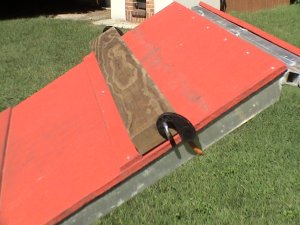Stride Regulators
21 Sep 2007
As their name suggests, Stride Regulators are used to assist dogs in using a particular stride pattern when performing the A Frame. The intent is to build the dog’s muscle memory for a fast and correct performance. This article shows several types of regulators and shows me using them in a video with Meeker.
When and Why
I’ve primarily seen regulators used on the downside of the A Frame. I think the narrow width of the dog walk makes their use there precarious. Although there was some discussion on the CleanRun Email List last year about it.
I haven’t seen people using stride regulartors to try to change their dog’s stride when ascenging the front side of the A Frame. If a dog is missing the upside contact other methods are typically used to help the dog.
The typical stride pattern desired for a big dog would be: striding over the top of the A Frame, taking a collecting stride midway down and striding into (or through in the case of a running A Frame) their contact position. This is sometimes called a “three stride A Frame”. Smaller dogs often add two more strides for a “five stride A Frame”.
The location of the regulators needs to be adjusted to each dog’s needs. Some dogs might only need one in one or the other location. The locations I show in the photos are usually a good starting place. To get dogs to clear the apex without taking a stride at the very top sometimes the first regulator is placed closer to the apex.
Construction
Stride regulators have been made out of all kinds of materials. In the photos below I show 4” and 2” diameter plastic drain pipe and wood 2 by 4s. Other materials include foam tubes and plastic planter box inserts. The regulators are cut to the width of the A Frame (or slightly shorter) and are held in place with “C” clamps (the quick adjust ones work best) or bungee cords.
If you use tube shaped regulators you can pass a bungee cord through the tube, under the A Frame and clip the ends together. I was surprised to find some 6 foot long bungee cords at a local Dollar Store. The big box home improvement stores also have adjustable length bungee cords.
4" Stride Regulators In Place

2" Stride Regulators In Place

I first saw wood stride regulators at Dana Pike’s place. By using 2x4s it gives you two different sized regulators all in one. Just put a screw eye offset in the end of the board and you can rotate the board. Another advantage of wood is you can paint the boards on two sides to help fade them as your dog doesn’t need them as much. A downside of the boards is they are hard and don’t “give” like foam or plastic tubing. Of course the boards should have their edges rounded and be free of rough surfaces. I used some pressure treated lumber left over from my deck so I can leave them outside year round. However, I’ve recently switched to the plastic drain pipe.
Wood Stride Regulators In Two Orientations


Other Thoughts
Not all trainers use or recommend using stride regulators. The most common objection is they can cause a dog to arrive in their end contact position with too much speed, or without their weight transfered back, and the impact on the dog’s front end is increased.
Some trainers only use a single regulator near the top of the A Frame to encourage their dog to stride over the apex but they then let their dog decrease their speed as their dog sees fit on the downside. So while their dog may take some extra strides when slowing down, they are willing to trade that time to reduce their dog’s stopping impact.
The type of contact position can also play into whether stride regulators are used:
- 2o2o: Two On - Two Off
- 4OTF: Four On The Floor
- 1RTO: One Rear Toe On
- No Stop: Running Contacts
Another approach is to place an electronic pad wired to a beeper in the contact area(s) and reward the dog for hitting those spots. Products like the Hit It Board Contact Trainer 2 are often used as a target for running contacts but can also be used when training just the striding portion of the behavior. I think an extra long version was also being talked about to span the entire A Frame width (the height would also fit between the slats).
I recently heard about a very promising new type of target/regulator that Rachel Sanders is using in place of this style of stride regulator. But it wouldn’t be appropriate for me to discuss it until I can ask Rachel for her permission to do so.
I think the bottom line is if you are considering using stride regulators I strongly recommend you work with someone familiar with their use and carefully evaluate your dog’s performance. A video camera is very helpful.
Stride Regulators In Action
To get an idea of how stride regulators can change a dog’s performance take a look at the video below. In the first two scenes without regulators you’ll see Meeker barely stride over the apex and then “shuffle” down the down side. The third scene uses on large regulator on the top and it helps him reach over the top a little more, but he still shuffles down the remainder. In the fourth scene I’ve used two large regulators and Meeker has his best performance (but he is still taking too short a stride over the lower regulator - so he ends up landing with his front feet on the ground at the bottom edge of the A Frame and takes another stride to get into position). In the fifth scene I’ve replaced the large lower tube with a smaller 2” tube. The final scene shows Meeker with two large regulators in slow motion so it is easier to see his stride pattern.
Related Articles
Click this link to search the whole site for “Stride Regulator”.
If you enjoyed this article won't you please:  Thanks!
Thanks!
